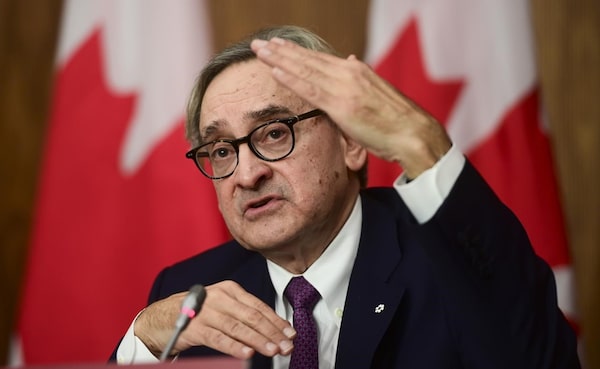
In an interview on Friday, chair of the Canada Infrastructure Bank Michael Sabia, seen here in Ottawa on Oct. 1, 2020, said his goal is to ensure the bank has a national approach.The Canadian Press
Canada Infrastructure Bank chair Michael Sabia says supporting large projects to expand irrigation in Western Canada is a priority as the bank seeks to boost economic growth in both urban and rural Canada.
To date, the bank’s most high-profile project is Montreal’s REM light rail line, and pledges of more public transit funding were prominent in an announcement from the bank on Thursday that it has identified $10-billion in priority areas for spending over the next two to three years.
In an interview on Friday, Mr. Sabia said his goal is to ensure the bank has a national approach. Thursday’s announcement included $2-billion to expand rural broadband and $1.5-billion for irrigation projects on Western Canadian farmland.
Canada Infrastructure Bank to name Ehren Cory new CEO, sources say
“It’s very much a priority. I think that there are real opportunities to take that forward,” Mr. Sabia said of the irrigation pledge, adding that it could be accomplished within reasonable timelines. “I think everyone is aware of the value and the importance of economic diversification in, well, everywhere, but certainly in Western Canada. Irrigation can play a very significant role in enhancing per-acre revenues, making Canadian farmers substantially better off.”
A recent report by Western Economic Diversification, a federal department, recommended that Ottawa support two proposed irrigation projects in Saskatchewan. The report concluded the economic benefits could boost Canada’s gross domestic product by $85-billion and would raise an additional $20-billion in net tax returns for governments. It also said the projects would create 27,800 person years of construction employment over a decade.
The report said the capital cost of the two projects, the Upper Qu’Appelle Canal and the Westside Irrigation Project, which would both divert water from Lake Diefenbaker, is a combined $3.27-billion.
The government of Saskatchewan announced its support for the two projects in July, with funding for preliminary engineering and initial construction. The province said at the time that it was seeking federal funds, including through the Canada Infrastructure Bank.
Saskatchewan Premier Scott Moe, who is in the midst of a provincial election campaign, said this week that he hopes the funding will come as a grant rather than a loan.
“I’m happy that the federal government has identified that it is a positive investment,” he said on Thursday.
Alberta Premier Jason Kenney also said this year that his government was in talks with the bank about funding irrigation work in southern Alberta. A provincial pandemic recovery plan released this summer included a focus on expanding irrigation infrastructure.
At an event in Calgary on Friday, Mr. Kenney said the province has been working with the infrastructure bank for several months on the issue of irrigation infrastructure and will have a related announcement next week.
“This will be the single largest investment in Alberta’s irrigation system in over 60 years,” he said. “A lot of the current infrastructure is very inefficient and it’s not good from a water-conservation point of view.”
Mr. Kenney said this could be a good year for agriculture, with a bumper crop and strong prices.
“Critical investment in Alberta agricultural infrastructure like irrigation can be another game-changer to increase yields and diversify the kinds of crops that we are producing,” he said.
Mr. Sabia is a former chief executive officer of the Caisse de dépôt et placement du Québec, the provincial pension fund. He is also a former member of the federal Advisory Council on Economic Growth, which published a 2016 report calling for the creation of a federal infrastructure bank and a 2017 report urging Ottawa to focus on strategic sectors, including agriculture.
The bank, which was created in 2017 with the goal of assisting projects that will attract support from large institutional investors such as pension funds, did not identify specific projects on Thursday.
Mr. Sabia said the funding structure of each project will vary, but he expects investors will be interested in the irrigation plans. He also said the bank places importance on supporting all regions.
“So that we’re both, geographically covering the country, and we’re covering both urban Canada and rural Canada,” he said. "And as a federal institution, as a national institution, I think it’s important that we are addressing needs that exist in both of those different domains.”
Tom Steve, general manager of the Alberta wheat and barley commissions, said upgrading the province’s irrigation system would be welcome, but that most Alberta crops do not require irrigation. He also said improved rural internet would be “a godsend” for farmers. He pointed out that agriculture was not a focus of the federal government’s recent Throne Speech.
“We still feel that our issues are not well understood in Ottawa," he said.
With a report from James Keller in Calgary
Know what is happening in the halls of power with the day’s top political headlines and commentary as selected by Globe editors (subscribers only). Sign up today.
 Bill Curry
Bill Curry